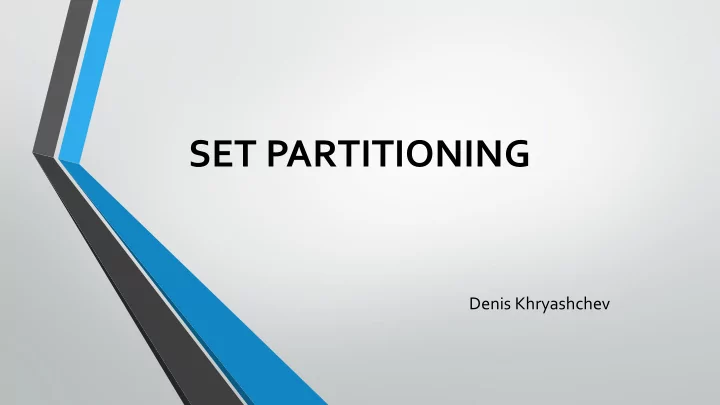

SET PARTITIONING Denis Khryashchev
INTRODUCTION
INTRODUCTION
PROBLEM STATEMENT
NUMBER OF PARTITIONS
MATHEMATICAL STATEMENT
MATRIX REPRESENTATION
MATRIX REPRESENTATION
MATRIX REPRESENTATION
MATRIX REPRESENTATION
MATRIX REPRESENTATION
MATRIX REPRESENTATION
MATRIX REPRESENTATION
PARTITION SOLUTION
PARTITION SOLUTION
GENETIC ALGORITHM
GENETIC THINKING FOR PARTITIONS
GENETIC EXAMPLE
GENETIC EXAMPLE
SEQUENTIAL GENETIC ALGORITHM 1. Initialization creates a starting population of a given size. 2. Evaluation assesses if the current population is “solution - like”. 3. Local search heuristics improves convergence of solution by selecting better candidates. 4. Mutation modifies the species of the population randomizing them. 5. Crossover combines two parents exchanging and scrambling their bits together to create a new species.
COMPUTATIONAL COMPLEXITY
NAÏVE PARALLEL SOLUTION
THE ISLAND MODEL ALGORITHM Separate and isolated subpopulations evolve independently in parallel. Occasionally, fit species (strings) migrate between subpopulations. The algorithm is programmed using a single-program multiple data (SPMD) model. The processors “synchronize” exchanging fit strings. The path to parallelism is the expansion of the original algorithm with a migration of the species between the islands.
THE ISLAND MODEL EXAMPLE
THE ISLAND MODEL EXAMPLE
THE ALGORITHM 1. When a fit species appeared or enough time passed since the last migration it’s time to migrate. 2. The top species migrate to the neighboring populations with send_string(). 3. At the same time the current population welcomes new migrants with recv_string(). 4. The less fit species replaced with the new ones.
THE PARALLELIZATION
COMPUTATIONAL COMPLEXITY
COST OPTIMAL?
THANK YOU ! Questions ?
Recommend
More recommend